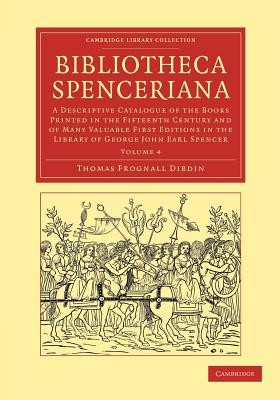
- Išsiųsime per 12–18 d.d.
- Autorius: Thomas Frognall Dibdin
- Leidėjas: Cambridge University Press
- ISBN-10: 1108051103
- ISBN-13: 9781108051101
- Formatas: 17.8 x 25.4 x 3.6 cm, minkšti viršeliai
- Kalba: Anglų
- Extra -15 % nuolaida šiai knygai su kodu: ENG15
Atsiliepimai
Aprašymas
At his death, George Spencer (1758-1834) had created the greatest private library in Europe. At the time, many aristocrats were spending huge sums acquiring rare printed books. With monastic and aristocratic libraries in Europe being dissolved, collectors had access to thousands of examples. The Second Earl Spencer's interests were in English 'black-letter' printing, especially the works of Caxton, and continental incunables, particularly first editions of Greek and Latin classics. Thomas Dibdin (1776-1847) was employed as Spencer's librarian and visited Europe searching for new acquisitions. Published in 1814-15, this catalogue is of the earliest and rarest items in the collection. Each is described in detail, with reproductions of woodcuts and engravings, making this a fascinating record of one man's commitment to collecting the earliest examples of this revolutionary invention. Volume 4 includes many examples of the earliest work of Caxton, alongside first editions of Boccacio and Dante.
EXTRA 15 % nuolaida su kodu: ENG15
Akcija baigiasi už 4d.00:46:32
Nuolaidos kodas galioja perkant nuo 5 €. Nuolaidos nesumuojamos.

- Autorius: Thomas Frognall Dibdin
- Leidėjas: Cambridge University Press
- ISBN-10: 1108051103
- ISBN-13: 9781108051101
- Formatas: 17.8 x 25.4 x 3.6 cm, minkšti viršeliai
- Kalba: Anglų
At his death, George Spencer (1758-1834) had created the greatest private library in Europe. At the time, many aristocrats were spending huge sums acquiring rare printed books. With monastic and aristocratic libraries in Europe being dissolved, collectors had access to thousands of examples. The Second Earl Spencer's interests were in English 'black-letter' printing, especially the works of Caxton, and continental incunables, particularly first editions of Greek and Latin classics. Thomas Dibdin (1776-1847) was employed as Spencer's librarian and visited Europe searching for new acquisitions. Published in 1814-15, this catalogue is of the earliest and rarest items in the collection. Each is described in detail, with reproductions of woodcuts and engravings, making this a fascinating record of one man's commitment to collecting the earliest examples of this revolutionary invention. Volume 4 includes many examples of the earliest work of Caxton, alongside first editions of Boccacio and Dante.





Atsiliepimai